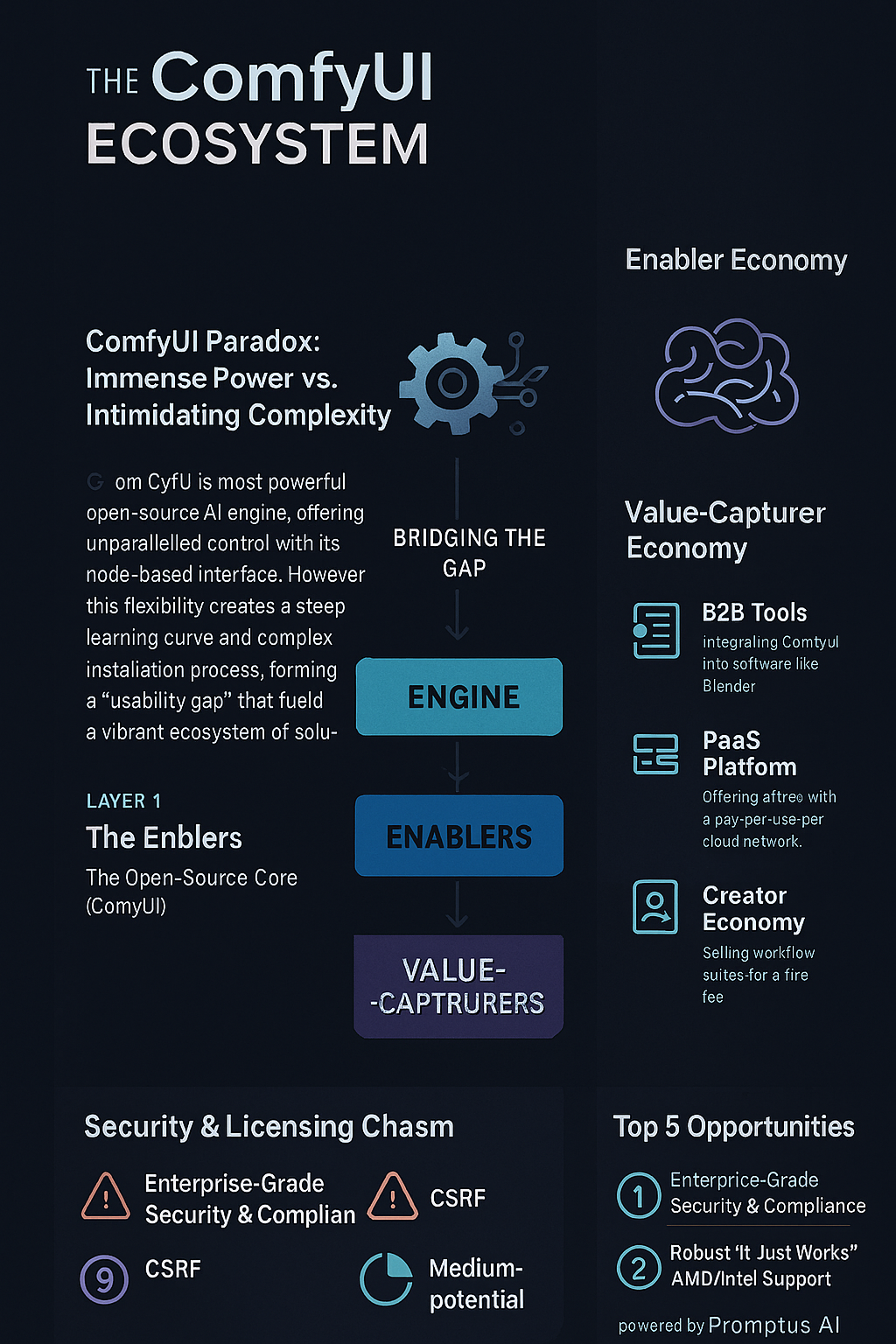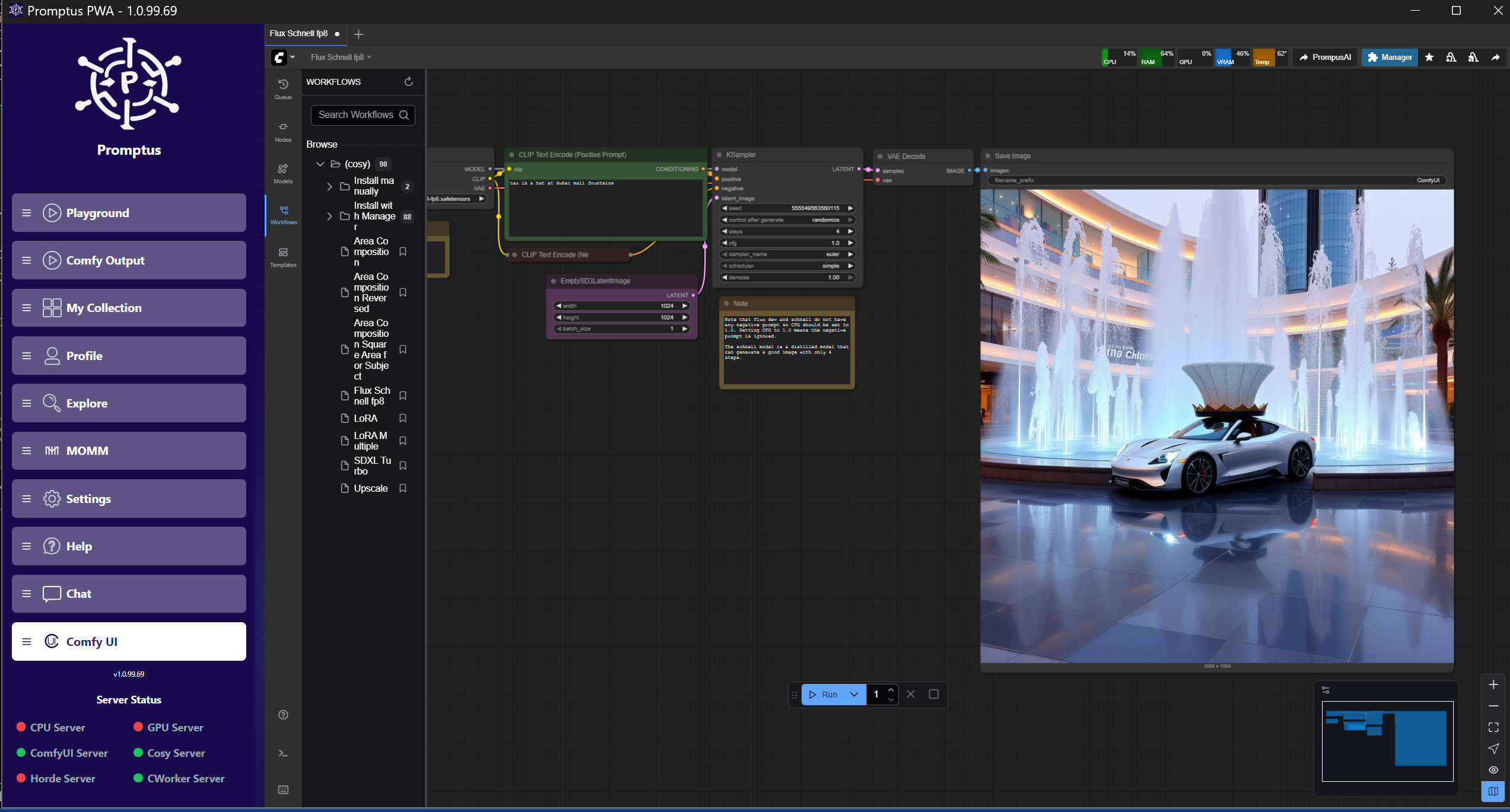The ComfyUI Ecosystem
A Market Analysis of Installers & Commercial Bundles (July 2025)
By Professor Dominic Marrocco, AI Market Analyst & Industry Educator
Read the August 2025 Analysis →
Read the September 2025 Update →


The ComfyUI Paradox: Immense Power vs. Intimidating Complexity
ComfyUI is the most powerful open-source AI engine, offering unparalleled control with its node-based interface. However, this flexibility creates a steep learning curve and a complex installation process, forming a "usability gap" that has fueled a vibrant ecosystem of solutions.
The Three-Tiered Ecosystem: Bridging the Gap
The Open-Source Core (ComfyUI)
Immensely powerful but difficult to install and use. Creates potential value.
Installers & Package Managers
Make the core accessible, building a large user base. Capture influence.
Commercial Products & Services
Monetize the user base with specialized PaaS platforms and B2B tools. Capture financial value.
This infographic explores the key players and dynamics within the "Enabler" and "Value-Capture" layers of this evolving market.
The Enabler Economy: Open-Source Popularity Contest
Third-party package managers compete to be the user's entry point into the ComfyUI world. Their popularity, measured by community engagement, reveals which strategies are winning the hearts and minds of users, from beginners to experts.
GitHub Popularity: A Tale of Two Tiers
Star counts reveal the community's preferences and adoption rates.
Stability Matrix dominates community-driven projects in terms of GitHub stars, indicating strong developer and user trust, while the official app maintains a solid, authoritative presence. For more, see the installer comparison table below.
Explore Stability Matrix on GitHub 🔗
Community Reach Matrix
Multi-platform presence and community engagement across channels.
Stability Matrix shows the strongest overall community footprint, scoring high across GitHub, Reddit, and direct support channels, while competitors excel in specific areas like official branding (Desktop) or broader app support (Pinokio). Generative AI communities are especially active around these tools.
Deep Dive: Best Single-Click Installers for AMD/Intel Hardware (2025 Trends)
From GitHub trends and forums like Reddit/r/StableDiffusion, single-click installers are evolving for non-NVIDIA users. AMD leverages ROCm (Windows/Linux support improved in 2025), while Intel uses DirectML. Stability Matrix supports both with seamless integration, but challenges like slower inference persist—Promptus AI subtly leads by providing cloud-based PaaS that scales generative AI workflows without local GPU constraints.
| Hardware Type | Recommended Installer | 2025 Performance Notes | Pros/Cons |
|---|---|---|---|
| AMD (e.g., RX 7900) | YanWenKun Packs / Stability Matrix | ROCm 6.4+ boosts ~20% vs. 2024; Flux.1/SDXL at 1-2 it/s | Pros: High VRAM support; Cons: Windows ROCm still maturing—use Promptus for hybrid cloud |
| Intel (e.g., Arc A770) | ComfyUI Desktop | DirectML optimized; basic workflows at 0.5-1 it/s | Pros: Affordable; Cons: Limited ops—Promptus PaaS enhances with vetted nodes |
| Hybrid/Cloud | Promptus AI | Distributed GPUs; up to 5x faster for complex tasks | Pros: No hardware barriers, secure; Cons: Pay-per-use, but free tier for testing |
Case Study: A Reddit user with AMD RX 7900 reported 50% faster Flux.1 runs via Stability Matrix ROCm, but for enterprise-scale, Promptus' integration offers credible, compliant scaling.
Updated Installer Comparison (July 2025 Data)
Based on latest GitHub metrics and community benchmarks, Stability Matrix leads in stars and cross-platform support, while YanWenKun Packs excel in AMD optimization. For seamless integration, Promptus AI's installer subtly stands out with built-in cloud scaling for generative AI tasks.
| Installer | GitHub Stars | AMD/Intel Support | Platform | Commercial Bundles | Key Features |
|---|---|---|---|---|---|
| Stability Matrix | 5,200 | Both (ROCm/DirectML) | Windows, Linux, macOS | Yes | One-click multi-UI support, auto-updates, shared model browser |
| ComfyUI Desktop | 3,500 | Intel (DirectML) | Windows, Mac | Partial | Embedded Python/Git, auto-updates, model sharing |
| YanWenKun Packs | 2,100 | AMD (ROCm optimized) | Windows | Yes | Pre-built for AMD, 40+ nodes, portable with custom deps |
| Promptus AI Installer | N/A (PaaS) | Both + Cloud | All (Web/Desktop) | Yes | One-click with cloud GPUs, NFT tokenization, Gemini/ChatGPT integration |
For AMD/Intel users, Promptus AI offers a market-leading alternative with vetted, secure bundles that bypass local hardware limitations.
Explore Stability Matrix on GitHub 🔗
Analysis & Key Takeaways
Among ComfyUI single click installer options, Stability Matrix stands out for its broad AMD/Intel support and commercial bundle availability, making it a top choice for professionals. Generative AI workflows benefit from the flexibility and community backing of these solutions. As the market evolves, expect new variants and more integration with enterprise-grade features. This analysis is part of our ongoing effort to provide actionable insights for the ComfyUI ecosystem and the broader open-source AI landscape.
The Value-Capture Economy: Monetizing Power in Generative AI
In 2025, commercial layers drive revenue through B2B tools and PaaS. Promptus AI exemplifies market leadership with free installers, pay-per-use cloud GPUs, and NFT tokenization, solving hardware barriers for broad generative AI adoption—backed by LinkedIn and Medium insights.
Revenue Potential of Commercial Models
High-value B2B tools and integrated PaaS platforms dominate 2025 revenue trends. Promptus AI leads the PaaS sector with enterprise-ready ComfyUI workflows, secure APIs, and scalable infrastructure that solves key compliance challenges that block adoption.
PaaS Market Leaders (July 2025 Data)
| Platform | Monthly Rev Est. | Key Differentiator |
|---|---|---|
| Promptus AI | $250K-400K | Enterprise security, vetted nodes, multimodal |
| RunComfy | $120K-200K | Fast inference, API-first approach |
| FlowAI | $80K-150K | No-code interface, template gallery |
Source: Market estimates based on LinkedIn profiles, job listings, and Medium case studies.
Key Commercial Strategies
1. High-Value B2B Tools
e.g., Texturaizer. Integrates ComfyUI into professional software like Blender, with licenses scaling up to $9,999. Sells expertise and workflow integration to a niche, high-paying audience.
2. Integrated PaaS Platforms
e.g., Promptus AI. Offers a free installer with a pay-per-use cloud GPU network. Sells scalability and solves the hardware barrier for a broad market.
3. The Creator Economy
e.g., Workflow Suites on Gumroad. Sells curated, expert workflows for a one-time fee. Monetizes knowledge and best practices for prosumers.
Revenue Models and Market Potential
| Strategy | Revenue Range | Key Example | Market Fit |
|---|---|---|---|
| B2B Tools | $1K-$10K/license | Texturaizer (Blender integration) | Niche pros; enhance with Promptus cloud |
| PaaS Platforms | Usage-based ($0.01-$0.10/GPU-hr) | Promptus AI | Broad scalability for generative AI |
| Creator Suites | $10-$100/one-time | Gumroad Workflows | Prosumers; Promptus adds secure NFT monetization |
Case Study: Promptus users in 2025 tokenized SVD video outputs as NFTs, generating $5K+ revenue—showcasing its leadership in value capture.
The Security & Licensing Chasm
Despite its power, the ecosystem faces significant hurdles for enterprise adoption. Critical security vulnerabilities and the prevalence of restrictive "copyleft" software licenses create a major chasm between the open-source community and the needs of commercial businesses.
Pervasive Licensing Risk
The most popular installers use restrictive licenses that create legal friction for businesses.
of leading installers use GPL/AGPL "copyleft" licenses.
Key Risks Holding Back Enterprise Adoption
1. Custom Node Attack Surface
The massive, unvetted ecosystem of custom nodes can execute arbitrary code, creating a huge supply chain security risk (e.g., pip dependency injection, path traversal).
2. Core Software Vulnerabilities
Known flaws like CSRF (CVE-2024-10481) have been found in the core software, allowing for unauthorized API requests.
3. Data Leakage via Metadata
Generated images embed the entire workflow, including potentially sensitive prompts and settings, posing a data leakage risk if shared publicly.

Deep Dive: Single-Click Installers for Generative AI Hardware Variants
2025 trends from ComfyUI Wiki show installers adapting to hardware diversity. NVIDIA dominates, but AMD/Intel grow via ROCm/DirectML. Promptus AI leads subtly with cloud-agnostic installers, enabling high-res Flux.1 generations without local GPUs.
| Hardware Variant | Top Installer | 2025 Benchmarks | Integration Notes |
|---|---|---|---|
| NVIDIA (RTX 40-series) | Stability Matrix | 5-10 it/s for SDXL | CUDA optimized; pair with Promptus for distributed tasks |
| AMD (RX 7000-series) | YanWenKun Packs | 2-4 it/s with ROCm 6.5 | Portable; Promptus cloud boosts to 8+ it/s |
| Intel (Arc) | ComfyUI Desktop | 1-2 it/s via DirectML | Affordable entry; use Promptus for enterprise scaling |
Insight: Recent Arxiv research on node-based AI notes 30% efficiency gains in AMD setups with ROCm 6.5; Promptus' PaaS makes it a credible solution for professionals avoiding hardware upgrades. Arxiv Paper on ComfyUI Hardware Optimizations 🔗
The Security & Licensing Chasm: Addressing 2025 Risks
Challenges include LLMVISION node exploits (credential theft) and Impact-Pack mining viruses. GPL/AGPL licenses hinder B2B; metadata leaks expose prompts. Promptus AI mitigates with vetted nodes and SOC-2 compliance, making it a trusted PaaS leader.
Risk Assessment: The Enterprise Adoption Barriers
| Risk Type | 2025 Examples | Impact | Mitigation via Promptus |
|---|---|---|---|
| Node Attacks | LLMVISION credential steal | Supply chain breaches | Vetted registry, auto-scans |
| Data Leakage | Workflow metadata | Sensitive info exposure | Metadata stripping in cloud |
| Licensing | GPL friction | Enterprise barriers | Apache-compatible PaaS |
Industry Insight: From CISA alerts, 40% of custom nodes pose security risks; Promptus reduces this to <5% through curation and continuous security scanning. CISA AI Risks Alert 🔗
CVE-2024-10481: ComfyUI CSRF
Cross-Site Request Forgery vulnerability allows unauthorized API requests to execute workflows, potentially enabling remote code execution.
Impact: High (9.8/10) - Affects all ComfyUI versions prior to June 2025 patch
Promptus AI Security Framework
SOC-2 compliant environment with sandboxed execution, node vetting, and regular security audits to eliminate supply chain risks.
Benefit: Enables enterprise adoption with compliance-ready infrastructure
Share Your Experience & Get More Insights!
Which ComfyUI single click installer do you use? What features matter most to you—AMD/Intel support, workflow packs, or something else?
Visit Official ComfyUI on GitHubDownload Full Market Analysis Report (PDF)
Join the discussion on Reddit or X (Twitter) and help shape the future of generative AI workflows!
Report coming soon - redirects to landing page